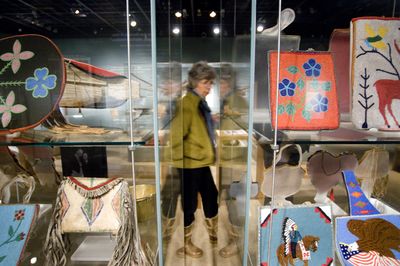Gregoire proposal combines museums
Cost-cutting effort draws criticism

Gov. Chris Gregoire wants to cover a small piece of the state’s projected shortfall by combining the Northwest Museum of Arts and Culture with the Washington State History Museum in Tacoma and merging the historical societies that oversee them.
But executives at both museums question whether the merger would save as much money as the budget watchers suggest, and say it could cost the MAC support from its donors.
Dennis Hession, the MAC’s interim chief executive officer, worries that some longtime supporters of the Spokane museum could cut back on donations if they thought their money was going to programs or expenses controlled elsewhere.
“We don’t believe that our efforts to promote an operation … that was organized and run out of Tacoma would have the same appeal,” Hession said.
$500,000 annual savings
The proposed changes to the museums and the historical societies are contained in Gregoire’s overall plan to cut some $5.7 billion in state spending and balance the biennial budget. Her proposal, released in mid-December, would merge the Eastern Washington State Historical Society with the Washington State Historical Society, creating a single board where two boards now exist. It would also cut state funds to the museums run by the societies by 10 percent, a cut similar to what many other state agencies are facing.
“It’s part of this larger proposal. We’re looking for ways to try to shrink government,” said Glenn Kuper, of the state’s Office of Financial Management.
State budget analysts say combining the historical societies would save about $500,000 a year, mainly through staff reductions. The merged operation could consolidate staff involved in administration, bookkeeping, information technology and exhibit preparation, Kuper said. There would also be some savings, albeit minimal, in taking two boards with about 30 members each and creating a single board with 30 or fewer members.
Historical society board members do not receive a salary, but do receive a per diem payment when they attend meetings. Each board oversees a museum – the MAC in the case of the Eastern Washington society, the state History Museum in the case of the Washington society – and appoints a top executive to run its operations.
In Spokane, that’s Hession, who is serving as interim CEO while the society searches for a permanent executive. In Tacoma, David Nicandri carries the title of state historical society director, with roughly the same duties as Hession.
Nicandri was quick to say the plan to merge the two societies and their museum operations did not come from the Tacoma-based organization.
“This is not an assignment we sought,” he said in a phone interview this week. “We have some significant concerns about this proposed legislation as well.”
Local donors could flee
Hession, the former mayor of Spokane, said he understands that the governor has a big task in trying to balance the state budget. But he thinks the savings Gregoire’s budget writers project won’t necessarily materialize. For example, even if the merged museums have a single chief executive in Tacoma, the MAC would still need a qualified manager, he said. The Spokane facility would still need people to answer the phones, book tours, and maintain exhibits and the building.
The budget proposes to provide some $3.8 million less than what the two historical societies and their museums received in the current two-year budget. The Washington society and the History Museum received $10.2 million in appropriated and non-appropriated funds in this cycle; the Eastern Washington society and the MAC received about $7.4 million. Next year the total operating budget for the combined historical society and the two facilities would be $13.8 million.
The proposed cuts could leave both museums “mortally wounded,” Hession said. The museums may have even less money if donors, who provide about half the funding for the MAC, reduce contributions because of concerns over how the money would be spent, he added.
Nicandri is also concerned about the effects of the budget cuts, which would come on top of any savings from merging the staffs. And with the economy continuing to slide, the budget cuts may grow. He also understands the MAC’s concern about losing local donor support.
“The issue of community support is of considerable consequence,” he said, particularly because the governor’s proposal gives the appearance that “they’re being merged into our (operation) rather than vice versa.”
Kuper said the governor envisions the merged historical society board would have equal representation from both sides of the state to ease concerns about loss of control.
“We would hope the (merged) board would be able to reach a consensus and a compromise” on how state money would be spent, he said. The board would have to respect the restrictions of any private donation that comes with “strings attached.”
The legislation to set up the merged board hasn’t been drafted, but whatever is proposed will be subject to legislative hearings where local concerns can be aired, Kuper said.
Differing missions
Another stumbling block could be the different characters of the two museums, Hession said. The Tacoma museum concentrates on history. The MAC, by its charter, combines history, art and an extensive collection of Native American artifacts, many of them culturally sensitive for local tribes.
To help oversee that collection, the Eastern Washington society set up an American Indian Cultural Council, with representatives from each of the Columbia Plateau tribes.
“They are the stewards of our collection,” Hession said. “These relationships take time. We’ve spent 10 years developing them.”
The cultural council, which wasn’t consulted by the state about plans to merge the societies and museums, is sending a letter to the Legislature objecting to the proposal, he said.
Nicandri said there would be no wholesale shifting of artifacts and other pieces from the MAC to Tacoma.
“I can’t envision how things could, would or should be moved from Spokane,” he said. “We’re rather cramped. We might propose moving some material to Spokane.”